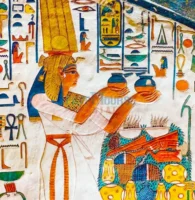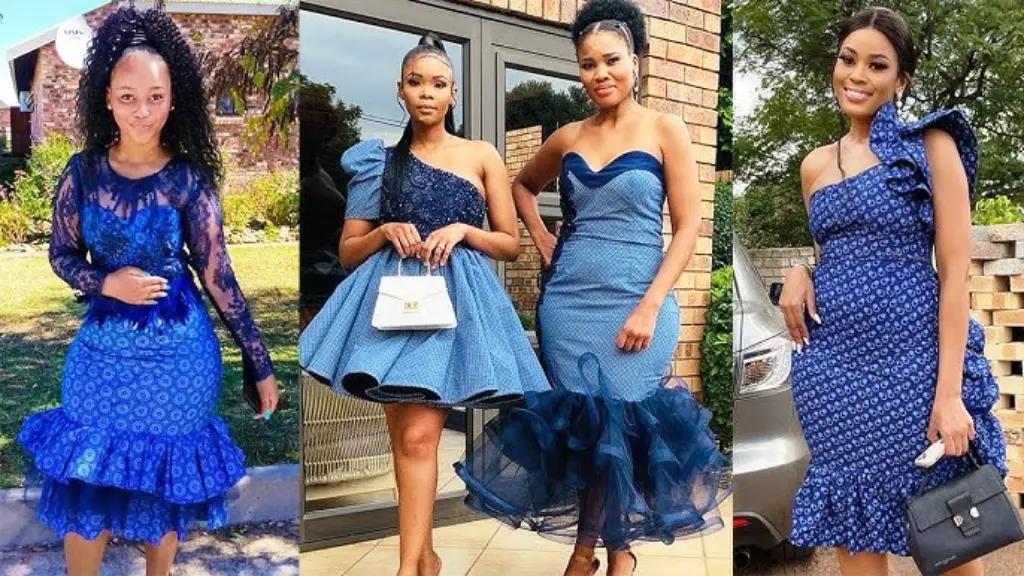Hey there, friend. Picture wrapping yourself in a fabric that hums with stories of kings, missionaries, and market stalls—bold blues, crisp whites, and patterns that dance like whispers from the Eastern Cape. That’s Shweshwe for you, a cotton canvas that’s equal parts history and heartbeat. If you’ve strolled Johannesburg’s streets or scrolled a fashion feed, you’ve likely spotted its geometric magic turning everyday outfits into cultural statements.
In this piece, we’ll trace its indigo roots, decode those iconic designs, and see how it’s striding into 2025 with fresh flair. Whether you’re a style explorer, a heritage seeker, or just love textiles that tell tales, come along. You’ll wrap up feeling ready to weave your own story with a thread of African pride.
Fabrics like Shweshwe do more than clothe—they connect. They link us to ancestors, artisans, and the earth itself. Let’s unfold this Southern African gem together.
The Roots of Shweshwe Fabric: From Indigo Imports to Basotho Badge
Envision the 1840s: French missionaries gift bolts of blue-dyed cotton to Lesotho’s King Moshoeshoe I. He drapes it over his people, and just like that, a European import becomes a royal emblem. Shweshwe—named after the king’s alias, Moshweshwe—sprang from this moment, blending global trade with local soul. But its story stretches further back, to 17th-century Dutch traders hauling indigo cloth from India and Java to Europe, then refining it into “blaudruck” prints via acid-discharge techniques.
See also 👑🐍🏺 Ancient Egyptian Fashion: A Journey Through Its Evolution and Historical Legacy
👑🐍🏺 Ancient Egyptian Fashion: A Journey Through Its Evolution and Historical LegacyGerman settlers in South Africa’s Eastern Cape amplified its spread, trading it with Xhosa communities who dubbed it “ujamani” (the German thing). By the 1930s, South Africa imported it en masse; locals starched it stiff for sea voyages, giving it that signature crunch. What started as settler wear morphed into a symbol of resilience—affordable, durable, and distinctly African.
Academics like Juliette Leeb-du Toit in Isishweshwe: A History of the Indigo-Discharge Dyed Cloth of Southern Africa (2017) unpack its evolution as a “clothing of cultural exchange,” bridging colonial imports and indigenous adaptation. From a Native lens, Xhosa elders in Eastern Cape oral histories recall it as “cloth that came with the strangers but stayed with us,” woven into blankets and skirts for everyday strength. Zulu voices echo this in community forums: “It’s our canvas now—patterns we paint with our lives.”
Whispered lore: Some say the name mimics the “shwe-shwe” swish of skirts in the wind—a sound of joy and motion.
A Timeline of Shweshwe‘s Bold Journey
To keep it crisp, here’s how this fabric folded into history:
See also 🎨 The Symbolism of Colors in Traditional Egyptian Garments
🎨 The Symbolism of Colors in Traditional Egyptian Garments| Year/Period | Key Milestone |
|---|---|
| 1600s | Dutch traders import indigo-dyed cloth from India/Java to Europe; resist-dye techniques emerge. |
| 1840s | French missionaries gift it to King Moshoeshoe I; named Shweshwe and popularized in Lesotho. |
| Late 1800s | German settlers bring “blaudruck” to Eastern Cape; Xhosa adopt as “ujamani.” |
| 1930s | South Africa becomes major importer; starched for durability during voyages. |
| 1980s | Local production ramps up; Da Gama Textiles pioneers in Eastern Cape. |
| 1992 | Da Gama buys “Three Cats” rights; original copper rollers shipped from UK—sole global producer. |
| 2000s | Fashion revival; designers like Thula Sindi blend into modern lines. |
| 2025 | Eco-innovations surge; UNESCO eyes intangible heritage nod amid global celeb collabs. |
This arc? From gift to garment, it’s pure adaptation.

Decoding the Design: What Makes Shweshwe Patterns Pulse?
Shweshwe isn’t just printed—it’s etched. Rolled on copper plates with acid to “discharge” white motifs from a solid dye base, it yields crisp geometrics that pop. At 90 cm wide, it’s tailor-friendly for skirts and wraps; 100% cotton calico keeps it breathable yet sturdy. Classic indigo leads, but reds, browns, and greens join the palette now.
Core Elements at a Glance
- Geometric Motifs: Diamonds for strength, circles for unity—Bantu-inspired symbols echoing fertility and community.
- Florals & Stripes: Roses nod to growth; lines mimic rivers, tying wearers to land.
- Picotage Technique: Tiny pin-dot textures add depth, a nod to old-world complexity.
- Symmetry & Repetition: Balanced repeats foster harmony; no chaos here—it’s ordered beauty.
- Color Symbolism: Indigo for wisdom, red for vitality; patterns shift meaning by shade.
A 2023 Textile History study highlights its ergonomics: starch fades post-wash for softness, ideal for all-day wear in hot climes. Xhosa artisans share: “Each dot is a prayer; the pattern, our map home.” Zulu perspectives add: “It’s math in cloth—symmetry like our beadwork, holding stories straight.”
Styling whisper: Let patterns lead—pair bold prints with neutrals for balance.
Cultural Significance: Shweshwe as Southern Africa’s Shared Thread
Shweshwe binds like no other. For Xhosa makoti (new brides), it’s a modesty wrap over ochre blankets; for Sotho wives, a daily dignity skirt. In Zulu isishweshwe, it’s the “denim of SA”—versatile, everyday armor. Worn at weddings, funerals, and markets, it levels fields: rich or rural, all shine equal.
Layers of Meaning in Every Motif
- Identity Weaver: Circles symbolize Basotho unity; triangles, Xhosa resilience—regional codes in cloth.
- Rite-of-Passage Power: Brides in Botswana’s leteisi variant; Tswana ceremonies with bold symmetrics.
- Economic Anchor: Sustains Eastern Cape mills; fights fakes from China with its salty tang and Three Cats stamp.
Leeb-du Toit’s research frames it as “Pan-African fusion,” worn by Zulus, Xhosas, Sothos alike—erasing divides. Native Xhosa tales from Transkei: “It came foreign, but we made it family—softens like our songs.” Zulu elders nod: “Patterns hold our proverbs; wear it, carry wisdom.” Yet challenges linger: Cheap imports erode jobs, but locals reclaim via boycotts and badges.
Shweshwe in Popular Culture: From Royal Robes to Runway Rebels
Shweshwe struts beyond borders. King Moshoeshoe’s endorsement made it legend; now, it’s celeb catnip. South African stars like Bonang Matheba rock it at galas, dubbing it “heritage haute.”
Spotlight Steals and Screen Magic
- Designer Darlings: Thula Sindi’s urban skirts; Sun Goddess’s global drops—Paris Fashion Week nods.
- Celeb Spotlights: Nomzamo Mbatha in Xhosa wraps for red carpets; AKA’s music vids with Zulu twists.
- Global Glow: Quilts in U.S. exhibits; Beyoncé’s “Cowboy Carter” tour teases Shweshwe accents.
- Film Flair: Tsotsi (2005) everyday heroes in aprons; 2025’s Rainbow Nation docuseries spotlights its revival.
It empowers: From stereotype to staple, Shweshwe owns the narrative.
For more African icons, check our Xhosa blanket guide or Basotho blanket traditions.
2025 Vibes: Shweshwe‘s Green Remix and Global Glow-Up
Enter 2025: Shweshwe sheds starch for sustainability. Da Gama’s organic cotton lines cut water use; recycled dyes bloom in eco-collectives. Queer designers fuse it with streetwear; UNESCO whispers heritage status.
Fresh Evolutions for Today
- Eco-Upgrades: Zimbabwe-sourced organics; GOTS-certified for fair farms.
- Fusion Flair: Shweshwe kinis by Refiloe Thaisi; net overlays for breathable twists.
- Youthful Yields: Slim skirts for Jozi youth; rainbow motifs in pride parades.
Xhosa innovators blend with beadwork: “Old roots, new shoots.” Fashion Practice (2024) calls it “decolonial design.” Zulu collectives add: “It’s our flag in fabric—wave it wide.”
Your Shweshwe Playbook: Styling and Sourcing Essentials
Ready to drape? Shweshwe shines versatile—respect its roots, remix with joy.
Easy Steps to Rock It
- Pick Your Print: Indigo for tradition, red for weddings. Check Three Cats stamp for authenticity.
- Layer Lightly: Wrap skirts over tees; add headscarves for flair. Wash once to soften starch.
- Fit Forward: Tailor loose for cultural ease; slim for urban edge. Breathable for SA heat.
- Occasion Matches:
- Wedding: Full makoti skirt, beaded bodice—pair with ochre shawl.
- Casual: Apron top with jeans; great for markets.
- Work: Pencil skirt, blouse—pro with pride.
Xhosa tips: “Let it flow—move like the patterns.” Zulu add: “Pair with beads; stories stack.” Ethical hack: Source Da Gama direct—supports 600+ jobs.
Explore our Shweshwe care guide for longevity.
Why Shweshwe Endures: Empowerment in Every Fold
From 1840s gifts to 2025 runways, Shweshwe proves: Take what’s given, make it yours. It’s South Africa’s quiet revolution—durable against divides, vibrant in unity. In fast-fashion flux, it calls for mindful wear: heirlooms over hauls, culture over copycats.
Leeb-du Toit nails it: “A blueprint for belonging.” Native voices affirm: Threads that tie us tight.
Step Into the Swish: Make Shweshwe Yours
Friend, why not? Swing by a Cape Town market—Da Gama bolts from R100/meter, custom skirts ~R500. Snap your wrap at a wedding; share the swish. Or gift a scarf kit—stitch connections ethically.
Back Native hands via Da Gama or co-ops. Practical: Washes like a dream. Empowering: Drape it, claim your colors.
What’s your fabric story? Drop below—let’s pattern a chat. Your heritage hues await. Go wrap bold.
